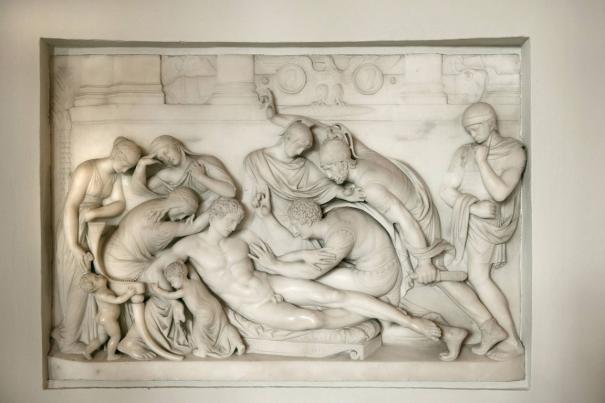About the Artist
Thomas Banks
Born: London, 22 December 1735
Died: London, 2 October 1810
Nationality: English
Collection
Private collection
Documentation:
Nancy Pressley discusses Banks's sources of inspiration:
"Poussin's much-admired work, then in the Barberini collection, is usually cited as having greatly influenced Banks's composition, but Gavin Hamilton's Andromache Mourning the Death of Hector (1761, now lost), exhibited at the Society of Artists [London] in 1762 and engraved by Domenico Cunego in 1764, is perhaps a more important source. Hamilton's innovative painting, itself influenced by Poussin, established the compositional complements for the deathbed scene, a popular theme in late eighteenth-century art. Banks's relief, which reverses Hamilton's design, repeats its frieze-like arrangement of the figures and strong horizontal accent. The seated figure of Agrippina echoes Hamilton's grieving Hecuba, while the wide curve made by the two generals bending towards the fallen hero repeats the rhythm of Andromache's body as she embraces Hector. The solder at the far right, whose pose is common to that of the mourning figures on antique reliefs, finds its counterpart in the figure of Helen at the far left in Hamilton's composition."
Nancy L. Pressley, The Fuseli Circle in Rome. Early Romantic Art of the 1770s (New Haven: Yale Center for British Art, 1979), 49.
Banks likely intended to express a political view in Germanicus:
"The sculpture was commissioned in marble by Thomas Coke, later Earl of Leicester, who installed it at Holkham Hall; there it was later joined by [Richard] Westmacott's Trial of Socrates and [Francis] Chantrey's Signing of the Magna Carta in a group that has been identified by modern scholars as a scheme in support of parliamentary reform. A Fox-ite Whig, Coke was one of the most fervent supporters of the Reform Bil and planned to commission Chantry to sculpt a statue of Napoleon for Holkham."
Julius Bryant, "The Royal Academy's 'violent democrat' Thomas Banks," The British Journal, vol. VI, no. 3 (Winter 2005): 53.
Other artists representing this subject:
Nicolas Poussin, Death of Germanicus, 1628 (Minneapolis Institute of Arts)
Heinrich Füger, Death of Germanicus, 1789 (Belvedere Museum, Vienna)
